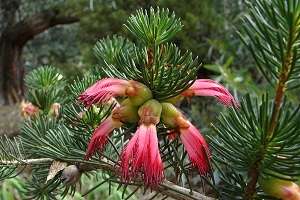Gene immigration continues despite fragmented landscapes

Human activity like clearing land for agriculture and mining does not threaten the ability of some plants to share genes via pollen carried by birds.
That's the finding of a recent study by WA researchers investigating gene flow in the rare endemic shrub Calothamnus quadrifidus ssp teretifolious in Western Australia's South West region.
Department of Parks and Wildlife research scientist Jane Sampson says many past studies in plant evolutionary genetics have come from America and Europe and the general 'rules' they produce around species fragmentation leading to genetic isolation and reductions in diversity and evolutionary potential don't always apply to Australian species.
"We have a lot of species that occur naturally in small isolated populations; that's just the nature of our landscape, so a lot of our species have been naturally fragmented for a long time," Dr Sampson says.
"With new genetic techniques, we can determine the source of pollen in seed crops, just like paternity analyses in humans.
"We found that the movement of pollen by birds was similar in fragmented and intact vegetation and the historical connectivity between populations has not been impacted by land clearing.
"So it is important to look after all patches of remnant vegetation in agricultural systems because all vegetation helps maintain connections across the landscape."
Calothamnus quadrifidus ssp teretifolious is a woody shrub, two to four metres tall that flowers profusely in spring and winter and is an important source of nectar for birds.
Dr Sampson says population genetics theory also suggests that 'in-breeders' or plants that self pollinate like Calothamnus quadrifidus ssp teretifolious build up 'genetic load' in their populations creating an 'evolutionary dead-end in terms of breeding systems'.
But this wasn't the case in the research, providing evidence for maintaining genetic diversity and showing it is important to understand the biology of local species that can be different to those elsewhere in the world.
The study surveyed a 50sq metre area near Busselton. Two groups of four populations 19km apart were selected ranging from intact to highly degraded.
Leaf material was collected from adult plants from each of the eight populations to assess genetic diversity.
Seed capsules collected from 10 randomly selected plants were dried, germinated and grown in a glasshouse for one month before tissue was harvested for DNA extraction.
The findings are detailed in a report in the journal Heredity titled 'Contemporary pollen-mediated gene immigration reflects the historical isolation of a rare, animal-pollinated shrub in a fragmented landscape'.
Journal information: Heredity
Provided by Science Network WA


















